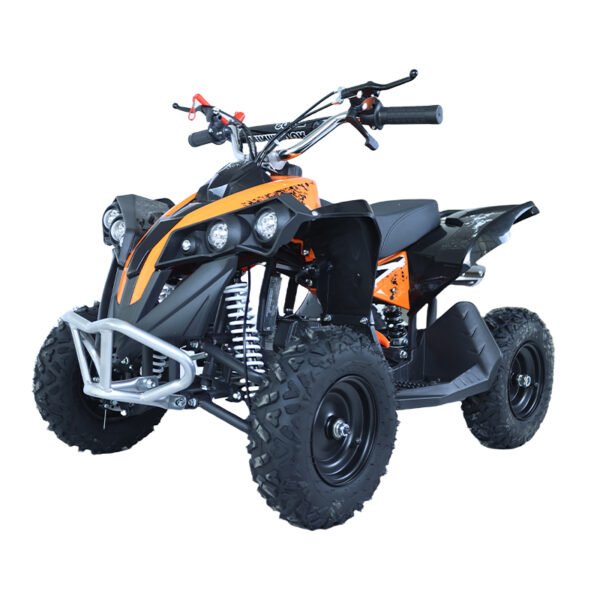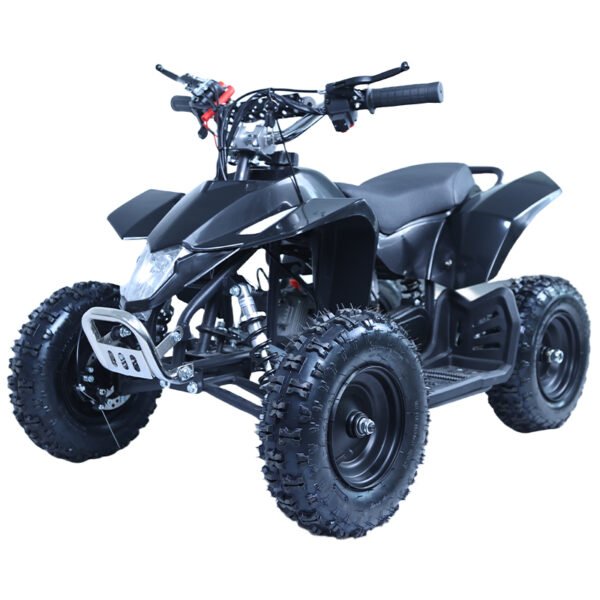
Detailed Insights into the 10 Trends Shaping the Future of ATVs
ATVs (All-Terrain Vehicles) have come a long way since their inception, evolving from basic utility vehicles to powerful machines designed for thrill-seekers and off-road adventurers alike.
As technology continues to progress and environmental concerns grow, the off-road vehicle industry is on the cusp of a major transformation.
In this article, we’ll explore the 10 major trends that will shape the future of ATVs and the off-road vehicle market.
1. Electric ATVs: The Rise of Sustainable Power
One of the most significant trends in the ATV industry is the shift toward electric-powered vehicles.
With growing concerns about the environment and sustainability, the demand for electric ATVs is rising.
These vehicles offer numerous benefits, including:
- Lower emissions: Electric ATVs have zero emissions, reducing the environmental impact of traditional gas-powered models.
- Quiet operation: Unlike their gas-powered counterparts, electric ATVs are much quieter, which is advantageous in nature reserves and public parks.
- Cost savings: With fewer moving parts, electric ATVs have lower maintenance costs.
Leading manufacturers like Valtinsu has already begun experimenting with electric models, and the trend is expected to grow rapidly in the coming years.
As battery technology improves, the performance and range of electric ATVs will also continue to increase.

2. Advanced Suspension Technology for a Smoother Ride
In the pursuit of improved ride quality and handling, suspension technology is evolving at a rapid pace.
ATV manufacturers are investing heavily in advanced suspension systems that offer smoother rides, greater control, and enhanced durability. Some notable advancements include:
- Longer suspension travel: This allows for better handling on rough terrain and makes high-speed off-roading smoother.
- Active suspension: Active suspension systems, which adjust in real-time based on terrain conditions, are becoming more common in high-end ATV models.
- Adjustable shock absorbers: Adjustable shocks allow riders to tailor their ride to specific conditions, improving comfort and performance.
Expect to see more ATVs with multi-mode suspension systems, where the rider can adjust the setup depending on the terrain—whether it’s rock crawling, sand dunes, or muddy trails.
3. Smart Technology Integration: The ATV of Tomorrow
The future of ATVs is undoubtedly connected. Smart technology is being integrated into ATVs to enhance safety, performance, and convenience. Features like:
- GPS tracking and navigation: Riders can now track their location and follow trails using integrated GPS systems.
- Bluetooth and app connectivity: Many new ATVs come with Bluetooth-enabled systems, allowing users to connect their smartphones for music, calls, or remote diagnostics.
- Ride data analytics: High-tech ATVs will allow riders to analyze their performance, track their route, and adjust their driving style using data collected from the vehicle.
These innovations not only improve the overall experience but also enhance safety, making it easier to monitor fuel levels, tire pressure, and other key metrics.
4. Autonomous and Semi-Autonomous ATVs
Although it may seem futuristic, autonomous ATVs are on the horizon.
Manufacturers are beginning to experiment with vehicles that can drive themselves, utilizing advanced sensors, GPS, and machine learning algorithms to navigate off-road environments.
While fully autonomous ATVs might take some time to reach the market, semi-autonomous models could be available in the next few years.
These vehicles would offer:
- Automatic braking: The vehicle could sense obstacles in its path and apply the brakes if necessary.
- Autonomous navigation: Advanced ATVs might be able to follow predefined routes or trails autonomously, reducing the stress on riders during long off-road adventures.
These developments have the potential to revolutionize ATV usage, especially in the context of rescue operations, agricultural use, and commercial applications.
5. Lightweight and Durable Materials for Enhanced Performance
As the demand for high-performance ATVs increases, manufacturers are focusing on lightweight yet durable materials to improve fuel efficiency, handling, and overall vehicle lifespan.
These materials include:
- Carbon fiber: Carbon fiber components are being used to reduce the weight of ATVs without compromising strength and durability.
- Aluminum alloys: Lighter than steel but just as tough, aluminum alloys are becoming more common in ATV frames and components.
- High-strength polymers: These advanced plastics are used for fenders, body panels, and other parts, offering both lightness and resistance to damage from impacts.
The use of these materials results in faster, more efficient, and stronger vehicles, which makes them perfect for rugged off-road conditions.
6. Enhanced Safety Features: Protecting Riders
Safety has always been a top priority for the ATV industry, but as technology advances, new safety features are emerging that promise to significantly improve rider protection.
Some of these innovations include:
- Roll-over protection: Advances in vehicle stability and suspension systems are making roll-overs less likely. Some new models are even incorporating roll cages to protect riders in case of a rollover.
- Traction control: Similar to the system used in cars, traction control on ATVs helps reduce wheel slip, providing better stability and control in tricky, off-road conditions.
- Integrated airbags: Some high-end models are starting to incorporate airbags that deploy in the event of a crash, cushioning the rider and reducing the risk of injury.
- Advanced rider sensors: These sensors can monitor a rider’s vitals, such as heart rate and body temperature, and alert emergency services if a crash is detected or if the rider’s health is at risk.
As more safety innovations become available, the future of ATVs will not only be more enjoyable but also much safer, minimizing risks for riders and passengers.
7. Customization and Personalization of ATVs
The demand for personalized off-road experiences is growing.
Riders are seeking ways to customize their ATVs to suit their specific needs, preferences, and style.
Future ATVs will offer:
- Modular designs: ATV manufacturers are shifting toward modular designs that allow riders to easily swap out parts, add accessories, and adjust configurations. This could include everything from wheel size to seat types and exhaust systems.
- 3D printing for parts: As 3D printing technology becomes more advanced, it’s possible that custom parts and accessories will be made on-demand, allowing for greater customization options.
- Aesthetic customization: From custom graphics and paint jobs to unique seat covers and lighting kits, aesthetics are becoming an essential part of ATV design.
This move toward personalization will allow riders to not only make their ATVs stand out but also optimize them for specific off-road challenges, such as rock crawling, mud racing, or desert exploration.
8. ATVs Designed for Specific Purposes: Specialized Models
With the off-road vehicle market expanding, manufacturers are creating specialized ATVs designed for different use cases.
These include:
- Utility ATVs: These are built for hard work, such as farming, construction, and forestry, with features like towing capacity, cargo racks, and specialized tires for heavy-duty tasks.
- Sport ATVs: Designed for high-speed performance, sport ATVs will continue to push the envelope with advanced engines, lightweight frames, and racing-focused suspension systems.
- Touring ATVs: These models are designed for long-distance riding, offering more comfort with larger fuel tanks, passenger seats, and extra storage space.
- Kids’ ATVs: With safety being a top priority, manufacturers are introducing smaller, slower ATVs with advanced safety features for young riders, ensuring a secure off-road experience for beginners.
Expect a broader range of specialized models in the future, catering to a more diverse range of riders, from professionals and farmers to thrill-seekers and families.
9. Hybrid ATVs: Combining the Best of Both Worlds
While fully electric ATVs are gaining popularity, there is still significant demand for traditional gasoline-powered ATVs due to their range and performance.
As a result, hybrid ATVs are emerging as a promising solution, combining the best features of both gas and electric powertrains.
Some benefits of hybrid ATVs include:
- Extended range: Hybrid models can switch between electric and gas power, offering a greater range than purely electric vehicles.
- Improved performance: The combination of electric torque and gas engine power results in more responsive acceleration and higher overall performance, perfect for demanding off-road terrain.
- Fuel efficiency: Hybrid models are typically more fuel-efficient than their purely gas-powered counterparts, reducing the need for frequent refueling.
Hybrid technology will allow manufacturers to cater to riders who want the flexibility of both worlds—electric efficiency for quiet, low-emission travel and gasoline power when longer range and performance are necessary.
10. Growth of the ATV Rental and Tour Industry
As ATVs become more popular, the rental and tour industry is set to grow.
The trend of renting ATVs for recreational purposes is gaining traction, especially in popular off-road destinations and national parks. Here’s why:
- Tourism: Off-road tours are becoming increasingly popular for adventure tourism, with travelers seeking unique and exciting ways to explore nature. Guided ATV tours through scenic areas offer thrilling experiences with an expert guide.
- Rising demand for rentals: As ATVs become more accessible to newcomers and casual riders, ATV rental services are expanding. This is especially popular in vacation spots, where people can enjoy off-roading without the commitment of buying an ATV.
- Eco-conscious tourism: As electric and hybrid ATVs gain popularity, eco-conscious tourists can enjoy off-road adventures without worrying about their environmental impact.
The growth of this sector will lead to more rental options, better tour infrastructure, and a greater awareness of safe and responsible off-road riding.
Conclusion: Embracing the Future of ATVs
The future of ATVs looks incredibly exciting, with technological advancements that promise to reshape the industry.
From electric and hybrid models to advanced safety features and smart technologies, the ATV market is on the verge of a major transformation.
As manufacturers innovate and respond to consumer demand for sustainability, performance, and personalization, we can expect off-road vehicles to become more efficient, safer, and enjoyable than ever before.
The off-road vehicle industry is evolving at a rapid pace, and the next decade will likely bring even more revolutionary changes.
Whether you’re an enthusiast, a casual rider, or a professional, staying up-to-date with these trends will be essential for making the most of your off-road adventures.
FAQs
1. Will electric ATVs become more affordable in the future?
Yes, as battery technology improves and manufacturing processes become more efficient, electric ATVs are expected to become more affordable, making them accessible to a wider range of consumers.
2. How can I customize my ATV for specific off-road conditions?
Many manufacturers offer modular ATV designs, allowing riders to swap out parts, adjust the suspension, and add accessories.
You can also consider working with custom shops that specialize in off-road vehicle modifications.
3. Are autonomous ATVs a realistic option for consumers in the near future?
While fully autonomous ATVs are still in the experimental stages, semi-autonomous features such as automated navigation and obstacle avoidance are becoming more common and will likely be seen in mainstream models in the next few years.
4. What safety features should I look for when buying an ATV?
Look for ATVs that include traction control, roll-over protection, advanced suspension systems, and airbag technology for maximum safety.
Additionally, some models come with built-in health monitoring systems.
5. Are hybrid ATVs available for purchase now?
Yes, hybrid ATVs are becoming more common, combining the benefits of gas and electric power for enhanced performance, range, and fuel efficiency.















